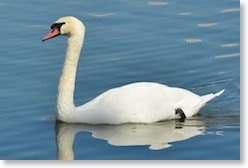 The swan, a waterfowl closely related to ducks and geese, is among the largest and most majestic of the flying birds. The mute swan and trumpeter swan can weigh 30 pounds with a wingspan of eight feet. The adult male is called a cob; the female, a pen. The baby swan is a signet or cygnet, and a batch of cygnets or eggs is a clutch. A group of swans is called a bevy or lamentation, and a group in flight is called a wedge. Most species of swans are migratory. Swans mate for life or at least for many years and build on the same nest each season. During the mating ritual, the male and female touch bill-to-bill and beast-to-breast to form a heart shape. The nest is about three feet across and is built on the ground near water. The male helps build the nest as well as assists in incubating the eggs. The baby swan hatches in just over a month and swims with its mother within a couple of days. Gray at birth, it becomes white in about a year. Both the female and male swan with eggs or chicks are fierce opponents of any perceived threat and can inflict serious injuries with their strong wings. Most of the six or seven species of swans are white, but the Australian black swan is black with white on the wings and has a red bill, and the South American black-necked swan is white with a black neck and head. In the 12th century, the Crown of England claimed ownership of all unmarked mute swans on the River Thames, the first pair having been given to Richard the Lion-Hearted for his part in the Crusades. The mute swan is a tourist attraction in Lake Morton in Lakeland, Florida. Not native to the area, some were brought in as pets in the 1920s but the small population had died out by 1954. Responding to a plea for help, Queen Elizabeth II donated two royal swans, and the birds made a dramatic come back from that original pair. (Friday Church News Notes, September 13, 2013, www.wayoflife.org [email protected], 866-295-4143) Comments are closed.
|
Archives
February 2020
|
Ads do not imply endorsement | Policy/Terms of Service | About Us | Contact Us | © Life Work Academy, Inc.
 RSS Feed
RSS Feed

